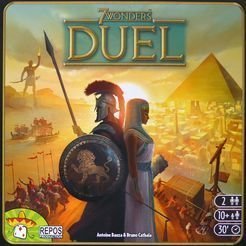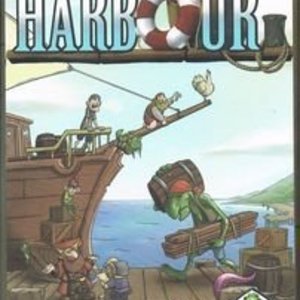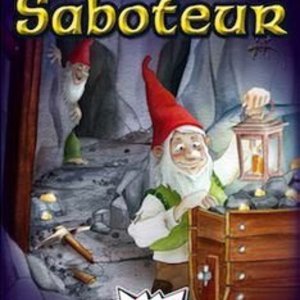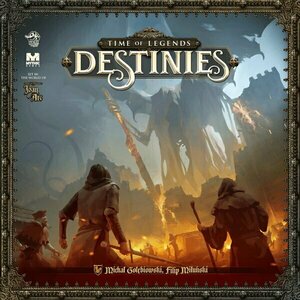Search
Search results
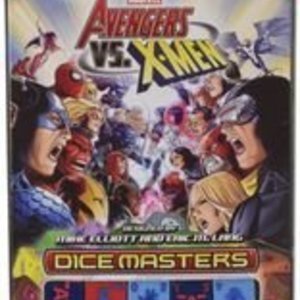
Marvel Dice Masters: Avengers vs. X-Men
Tabletop Game
Marvel Dice Masters: Avengers vs. X-Men is a collectible dice-building tabletop game designed by...
Purple Phoenix Games (2266 KP) rated 7 Wonders Duel in Tabletop Games
Oct 26, 2021
The original 7 Wonders was my #1 game of all time for a long while. While it has since dropped off my Top 10, I still have so many fond memories of it. Now, I know I am not breaking any stories here by finally reviewing its 2-player successor, but this game is really streamlined and fabulous. Obviously it is wonderful as it has earned the Purple Phoenix Games Golden Feather Award! But why do we love it so much?
7 Wonders: Duel is a 2-player tableau and engine-building card game set in the 7 Wonders game universe where players collect cards to create an engine to gain VP using any number of winning strategies. The game takes place over three ages and the player with the most VP at the end of the game, becomes victorious via military supremacy, or wins via scientific supremacy.
To setup, place the game board between the players with the green Progress tokens, Military tokens, and red Conflict pawn upon it. Shuffle the Age I cards and lay them according to the rule book (this formation changes for each age. Age I is setup in the photo below). Each player receives seven gold and they draft their Wonders according to the process in the rules.
On a turn the active player will choose one uncovered face-up card to be used one of three different ways. The card can be added to the player’s tableau and “built” by spending resources required, if any. The card may be discarded in exchange for coins totaling 2 + the number of yellow cards built in the player’s city. Lastly, the card may be used to build a player’s Wonder card by inserting it below the Wonder and paying the cost, as in 7 Wonders proper. The next player will then take their turn.
If on a turn a player builds certain card types into their city, special actions are taken. This happens as a result of building Military or Science cards. When a player builds a Military (red shield icon) card they immediately move the Conflict token on the board one space toward their opponent’s Capital (the end of the board closest to the opponent). Should a player force the Conflict token to reach their opponent’s Capital, the attacking player immediately wins! The other special action that can be taken is with a pair of Science cards being built. For every pair of like-symbol Science cards built, the active player may choose to take one of the Progress tokens from the game board and add it to their collection. These tokens can be very powerful, and just as in 7 Wonders proper, Science is a viable yet difficult strategy. Should a player build any six unique Science icons on cards they will immediately win!
If a Military or Science supremacy victory is not achieved, the game continues to Age II, where setup of the cards is different, but play remains the same. Similarly, Age III is setup differently still and has the added bonus of three random Guild cards, which may add significant strategic icons or abilities. At the end of Age III the players count their VP from the various sources listed in the rule book and the ultimate champion is then crowned!
Components. This game comes in a very small box, so the components are also quite small. I believe myself to have medium-sized man-paws and I have not had any issues with size of components. They are all very high quality, as is to be expected from Repos Production, and are fantastically illustrated. The Conflict token is enticingly menacing, and it lures me into concentrating on a Military victory every time I play. I need to just ignore it, but it’s so beautiful! All in all, the components are great, and even though the cardstock is relatively thin, my copy has withstood many plays and has seen very little wear and tear.
So 7 Wonders: Duel exists for all those players who love 7 Wonders but do not wish to play it with the 2-player variant rules. While Duel is certainly a little sibling, it is also its own beast of a game and should be treated as such. There are several key changes in rules for Duel, such as the trading with the BANK for missing resources upon building versus paying a neighbor to borrow their resource production. Also, the obvious change of adding a board with an ever-dancing Conflict token is unique to this title. Wonders are treated differently and instead of receiving one Wonder with three layers, Duels gives each player four Wonders with just one layer.
Aside from the differences between the two games, I do believe that if you are a fan of one you will also like the other. I can see, though, gamers who dislike 7 Wonders enjoying the smaller 7 Wonders: Duel. There is just something about being able to focus on one other player and agonizing over every turn so that your opponent receives a useless card from the offer, or taking every Military or Science card possible so as to end the game as quickly as possible. My brother, Bryan, greatly dislikes 7 Wonders, but he does not mind playing Duel, or at least that is what he led me to believe…
Myself, though, I think I still prefer original 7 Wonders, and I believe it is because I can soar through a game of it in under 15 minutes while holding a conversation with the other players (as long as they have played before and are very comfortable with the rules). Duels creates a more intimate feeling and eats up more of my brainpower. Purple Phoenix Games has awarded 7 Wonders Duel the coveted Golden Feather Award, so we agree that this is a fabulous game. If you have been waffling over grabbing a copy of Duels, please do yourself a favor and just purchase it! I promise you will have a great time with it, and if you end up disagreeing with me, let me know. We can play whatever you like next time we meet.
7 Wonders: Duel is a 2-player tableau and engine-building card game set in the 7 Wonders game universe where players collect cards to create an engine to gain VP using any number of winning strategies. The game takes place over three ages and the player with the most VP at the end of the game, becomes victorious via military supremacy, or wins via scientific supremacy.
To setup, place the game board between the players with the green Progress tokens, Military tokens, and red Conflict pawn upon it. Shuffle the Age I cards and lay them according to the rule book (this formation changes for each age. Age I is setup in the photo below). Each player receives seven gold and they draft their Wonders according to the process in the rules.
On a turn the active player will choose one uncovered face-up card to be used one of three different ways. The card can be added to the player’s tableau and “built” by spending resources required, if any. The card may be discarded in exchange for coins totaling 2 + the number of yellow cards built in the player’s city. Lastly, the card may be used to build a player’s Wonder card by inserting it below the Wonder and paying the cost, as in 7 Wonders proper. The next player will then take their turn.
If on a turn a player builds certain card types into their city, special actions are taken. This happens as a result of building Military or Science cards. When a player builds a Military (red shield icon) card they immediately move the Conflict token on the board one space toward their opponent’s Capital (the end of the board closest to the opponent). Should a player force the Conflict token to reach their opponent’s Capital, the attacking player immediately wins! The other special action that can be taken is with a pair of Science cards being built. For every pair of like-symbol Science cards built, the active player may choose to take one of the Progress tokens from the game board and add it to their collection. These tokens can be very powerful, and just as in 7 Wonders proper, Science is a viable yet difficult strategy. Should a player build any six unique Science icons on cards they will immediately win!
If a Military or Science supremacy victory is not achieved, the game continues to Age II, where setup of the cards is different, but play remains the same. Similarly, Age III is setup differently still and has the added bonus of three random Guild cards, which may add significant strategic icons or abilities. At the end of Age III the players count their VP from the various sources listed in the rule book and the ultimate champion is then crowned!
Components. This game comes in a very small box, so the components are also quite small. I believe myself to have medium-sized man-paws and I have not had any issues with size of components. They are all very high quality, as is to be expected from Repos Production, and are fantastically illustrated. The Conflict token is enticingly menacing, and it lures me into concentrating on a Military victory every time I play. I need to just ignore it, but it’s so beautiful! All in all, the components are great, and even though the cardstock is relatively thin, my copy has withstood many plays and has seen very little wear and tear.
So 7 Wonders: Duel exists for all those players who love 7 Wonders but do not wish to play it with the 2-player variant rules. While Duel is certainly a little sibling, it is also its own beast of a game and should be treated as such. There are several key changes in rules for Duel, such as the trading with the BANK for missing resources upon building versus paying a neighbor to borrow their resource production. Also, the obvious change of adding a board with an ever-dancing Conflict token is unique to this title. Wonders are treated differently and instead of receiving one Wonder with three layers, Duels gives each player four Wonders with just one layer.
Aside from the differences between the two games, I do believe that if you are a fan of one you will also like the other. I can see, though, gamers who dislike 7 Wonders enjoying the smaller 7 Wonders: Duel. There is just something about being able to focus on one other player and agonizing over every turn so that your opponent receives a useless card from the offer, or taking every Military or Science card possible so as to end the game as quickly as possible. My brother, Bryan, greatly dislikes 7 Wonders, but he does not mind playing Duel, or at least that is what he led me to believe…
Myself, though, I think I still prefer original 7 Wonders, and I believe it is because I can soar through a game of it in under 15 minutes while holding a conversation with the other players (as long as they have played before and are very comfortable with the rules). Duels creates a more intimate feeling and eats up more of my brainpower. Purple Phoenix Games has awarded 7 Wonders Duel the coveted Golden Feather Award, so we agree that this is a fabulous game. If you have been waffling over grabbing a copy of Duels, please do yourself a favor and just purchase it! I promise you will have a great time with it, and if you end up disagreeing with me, let me know. We can play whatever you like next time we meet.

Downhill Xtreme
Games and Entertainment
App
JOIN OVER 12 MILLION RACERS AROUND THE WORLD!! Tear past the competition on a fierce ride to the...
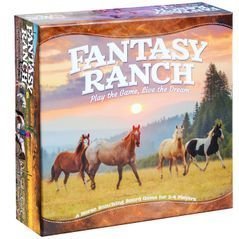
Fantasy Ranch
Tabletop Game
Welcome to Fantasy Ranch! Kick off your boots and pull up a chair for a game where all your dreams...
Purple Phoenix Games (2266 KP) rated Scoville in Tabletop Games
Jan 14, 2020
Have you ever had that thought, where you were sitting, wondering, has there ever been a board game based on “x” theme? Something really obscure, that you were for sure no one has ever thought of before. I think those of us that are avid collectors have this thought often, and it can be quite amusing at times. Sometimes the thought enters our head as this grand world domination scheme where you are going to be the first person to invent this new abstract and ludicrous board game that everyone is going to buy, making you filthy rich! And other times, the thought is just one of those that exists at the very far back stretches of your brain, jusssst to see how comical a title/theme you can come up with. Well, let me welcome everyone to “Scoville” – the board game I bet you never thought existed…..well, until now that is.
“Scoville” is exactly what you are thinking. Well, if you are a pepper fan or afficionado anyway. You see, Scoville, a term specifically made up by a fellow pepper enthusiast, is a test that measures the “hotness” of a pepper. The test was first used by Wilbur Scoville in 1912, whose namesake became the prodigious word used across the world to catalogue the finest and hottest peppers. The test has become so popular, that each year, farmers across the world make attempts to cross-breed peppers to make even hotter ones, just so they can stake a claim at the highest level of the Scoville scale.
Now that you have an idea of what our theme is all about, let’s talk gameplay. In Scoville, you play a pepper farmer. Your goal is to plant, sell, and breed the hottest peppers in all of town, suitably named, “Scoville.” There are 5 phases in each round of the game. Players complete these 5 phases in order until afternoon occurs in the game. This happens when a set amount of peppers have been sold by the farmers in the “marketplace” based on player count. These 5 phases: Auction, Plant, Harvest, Fulfillment, and Time Check, are described in the rulebook in a short, but thorough way. Each “morning” in the game, farmers take turns selling their peppers for victory points, planting new peppers in the open field plots, harvesting and breeding new peppers to sell later, and completing orders. It sounds like a lot, but the gameplay is one of the smoothest I have experienced in a worker placement style game. It’s unique in that it isn’t truly worker placement where you fill a space and another player is then blocked. The field in this case is wide open and provides ample direction for multiple strategies to get the best peppers on your turn. Once enough peppers have been sold based on the rulebook’s conditions, players enter the “afternoon” phase where they will sell peppers and fulfill any remaining orders they can. Once all players have completed this last trek through the 5 phases, victory points are added up. You’ll get varying points for all orders fulfilled throughout gameplay, points for special award plaques such as the hottest pepper award, points for unused Bonus tiles you are provided at the start (essentially little bumps in the game so no one person can run away with the scoring), and finally points for all money you have left from selling peppers in increments of $3.
While I have only scratched the surface of the breadth of gameplay this game offers, it is by far one of the simplest, yet most strategic, worker placement board games I have come across. The theme is in a very specific niche, yet is so whimsical and fun because of how the game is organized and crafted. It is very accessible for the whole family, and I say even usable as a first gateway game into the worker placement genre. The designer has done great not to let the theme weigh down the game to the point of that typical analysis paralysis that sometimes becomes the crux of most worker placement games. To clarify, actions such as “watering” or “fertilizing” the peppers could have been added to amplify the theme further, but are not included I believe because it truly doesn’t take away from the gameplay and imaginative idea that we are true pepper farmers. Just because we are “farmers” doesn’t mean we have to complete every task a farmer might do. We just have to feel like we are growing some really cool looking peppers (which the unique pepper meeples do the trick!)
While the theme is quite specific to a certain niche of gamer/pepper afficionado, it certainly makes up in fun gameplay that really anyone can enjoy, even us light-weight pepper eaters. It actually gives us light-weights a place to feel inclusive in this world of burn-your-face-off exhilarance that is so apparent on the faces of those that can tackle the likes of the dreaded Ghost pepper or Carolina Reaper. Purple Phoenix Games gives this one a hot 10 / 12. I hope you consider picking up a copy of this at your local game store and give it a try. You won’t regret it. And hey, good luck discovering all sorts of new and exciting types of those hot hot little death pickles!
“Scoville” is exactly what you are thinking. Well, if you are a pepper fan or afficionado anyway. You see, Scoville, a term specifically made up by a fellow pepper enthusiast, is a test that measures the “hotness” of a pepper. The test was first used by Wilbur Scoville in 1912, whose namesake became the prodigious word used across the world to catalogue the finest and hottest peppers. The test has become so popular, that each year, farmers across the world make attempts to cross-breed peppers to make even hotter ones, just so they can stake a claim at the highest level of the Scoville scale.
Now that you have an idea of what our theme is all about, let’s talk gameplay. In Scoville, you play a pepper farmer. Your goal is to plant, sell, and breed the hottest peppers in all of town, suitably named, “Scoville.” There are 5 phases in each round of the game. Players complete these 5 phases in order until afternoon occurs in the game. This happens when a set amount of peppers have been sold by the farmers in the “marketplace” based on player count. These 5 phases: Auction, Plant, Harvest, Fulfillment, and Time Check, are described in the rulebook in a short, but thorough way. Each “morning” in the game, farmers take turns selling their peppers for victory points, planting new peppers in the open field plots, harvesting and breeding new peppers to sell later, and completing orders. It sounds like a lot, but the gameplay is one of the smoothest I have experienced in a worker placement style game. It’s unique in that it isn’t truly worker placement where you fill a space and another player is then blocked. The field in this case is wide open and provides ample direction for multiple strategies to get the best peppers on your turn. Once enough peppers have been sold based on the rulebook’s conditions, players enter the “afternoon” phase where they will sell peppers and fulfill any remaining orders they can. Once all players have completed this last trek through the 5 phases, victory points are added up. You’ll get varying points for all orders fulfilled throughout gameplay, points for special award plaques such as the hottest pepper award, points for unused Bonus tiles you are provided at the start (essentially little bumps in the game so no one person can run away with the scoring), and finally points for all money you have left from selling peppers in increments of $3.
While I have only scratched the surface of the breadth of gameplay this game offers, it is by far one of the simplest, yet most strategic, worker placement board games I have come across. The theme is in a very specific niche, yet is so whimsical and fun because of how the game is organized and crafted. It is very accessible for the whole family, and I say even usable as a first gateway game into the worker placement genre. The designer has done great not to let the theme weigh down the game to the point of that typical analysis paralysis that sometimes becomes the crux of most worker placement games. To clarify, actions such as “watering” or “fertilizing” the peppers could have been added to amplify the theme further, but are not included I believe because it truly doesn’t take away from the gameplay and imaginative idea that we are true pepper farmers. Just because we are “farmers” doesn’t mean we have to complete every task a farmer might do. We just have to feel like we are growing some really cool looking peppers (which the unique pepper meeples do the trick!)
While the theme is quite specific to a certain niche of gamer/pepper afficionado, it certainly makes up in fun gameplay that really anyone can enjoy, even us light-weight pepper eaters. It actually gives us light-weights a place to feel inclusive in this world of burn-your-face-off exhilarance that is so apparent on the faces of those that can tackle the likes of the dreaded Ghost pepper or Carolina Reaper. Purple Phoenix Games gives this one a hot 10 / 12. I hope you consider picking up a copy of this at your local game store and give it a try. You won’t regret it. And hey, good luck discovering all sorts of new and exciting types of those hot hot little death pickles!
The Marinated Meeple (1853 KP) rated Maori in Tabletop Games
Jun 8, 2018
Simple (2 more)
Easy to Teach
Fun Polynesian theme
Carcassone level of simplicity with good depth and a Polynesian theme
I teach this to "non-gamers" all the time and we even take it with us on vacation. The game is simple, there is a 4 by 4 grid of tiles to choose from, and you move a little boat around the board one or two spaces and take one of those tiles. you have some shells you can use to move the boat further or inside to the middle tiles. you can also get more boats to move further. You also have a player mat in which to place the newly acquired tiles, but one you place them you can't move them. Each tile has different values based on what you have around it, you try to create islands, and huts double the scoring trees. This is just the Gist, there is more to it, and there is event a backside to the board for extra challenge. we like this one a lot for those nights when a heavy game doesn't appeal to us, or we are sitting no the deck with a glass of wine, unwinding. we want to play and have fun without thinking too hard. Thee is a fun trying to place yourself just right so that someone else can't reach on the next turn, but then you will. I highly recommend this one.
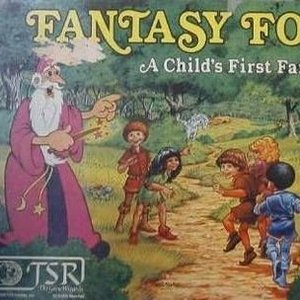
Fantasy Forest
Tabletop Game
A children's fantasy game from the makers of Dungeons & Dragons Adventure Game. Each player is a...
Boardgames Retrogames DnDGames
Purple Phoenix Games (2266 KP) rated Harbour in Tabletop Games
Dec 19, 2019
“Ugh, I have too much stone and not enough fish! What am I going to do, just magically convert this stone into fish?” In Harbour, the answer is YES. Harbour is a light economic, worker placement, set collection game with fantasy elements to spice up the theming. Your goal is to amass the most victory points at the end of the game and become the greatest Harbourmaster ever!
In Harbour, you control a gobleeple (I am really horrible at this, but it’s a meeple in the shape of a goblin) who travels around town visiting buildings to enact their special abilities. Using these abilities will help you amass goods whose value is ever-changing on a uniquely-designed market board. Knowing when to sell your wood and livestock to purchase buildings is the key factor to creating a strategic path to income and winning the game of Harbour.
DISCLAIMER: I do not intend to cover every single rule included in the rule book, but will describe the overall game flow and major rule set so that our readers may get a sense of how the game plays. For more in depth rules, you may purchase a copy from the publisher directly or from your FLGS. Furthermore, there is an expansion to this game, but we are not reviewing it at this time. Should we review it in the future we will either update this review or post a link to the new material here. -T
To setup give each player a gobleeple of their color choice (I choose you, purple!), a player board of their choice – or randomly dealt, and one token of each good to later be placed on their warehouse spaces. Place the main market board in the middle of the table with one goods token per space on the market to indicate starting prices for each good. Have each player now assign goods to warehouse spaces not to exceed three total goods stored. Shuffle the main building cards and place out in a grid a number of cards equal to three plus the number of players (seven total in a four-player game). Determine the starting player and you are ready to begin!
On your turn you must move your gobleeple to another vacant building, even the starting one on your player mat, or another player’s built building (but you must pay them a good to do so). From there you may take advantage of any special abilities that building offers. It could be adjusting the prices of goods, trading one type of good for another, or allowing you to purchase buildings from the grid. Purchasing buildings brings the game closer to its end, as the end is triggered by a player purchasing their fourth building. The round continues until everyone has had equal amount of turns and the player with the highest VP in buildings wins! I will have you play the game to see the various abilities that each player mat and each building offer.
Components. This is a small game in a small box (ironically it’s a Scott Almes design – you know, of Tiny Epic fame). You are given lots of player mats that feature different characters and abilities that you can choose to emulate. These mats are great, laid out well, and have funny flavor text on them. Also included are the aforementioned painted wooden gobleeples in fun colors and with an even funner shrugging pose. To keep track of your goods and market values you use blocks with stickers applied. In addition to this is a giant stack of cards to represent the buildings you will be visiting and purchasing. I have sleeved mine and they all fit back in the box (even with a few promos included). Everything is of great quality. No problems at all for me, as per usual with Tasty Minstrel Games fare.
I do not own many market and economic games because usually they do not really interest me at all. I do have many worker placement games because I really enjoy the mechanic. This one, though, is special to me. It is one of the games I have Kickstarted that I feel really delivered and fires on all cylinders for me. Your opinions may vary if you have played it, but this game is an absolute gem. It is light, fast, and incredibly fun. There is a slight learning curve if you are not used to either economic or worker placement games, but after a few rounds it will all fall into place. If you are looking for a euro game in fun clothing, I highly recommend Harbour (and it’s a steal right now in stores). Purple Phoenix Games gives this one a rousing 10 / 12.
In Harbour, you control a gobleeple (I am really horrible at this, but it’s a meeple in the shape of a goblin) who travels around town visiting buildings to enact their special abilities. Using these abilities will help you amass goods whose value is ever-changing on a uniquely-designed market board. Knowing when to sell your wood and livestock to purchase buildings is the key factor to creating a strategic path to income and winning the game of Harbour.
DISCLAIMER: I do not intend to cover every single rule included in the rule book, but will describe the overall game flow and major rule set so that our readers may get a sense of how the game plays. For more in depth rules, you may purchase a copy from the publisher directly or from your FLGS. Furthermore, there is an expansion to this game, but we are not reviewing it at this time. Should we review it in the future we will either update this review or post a link to the new material here. -T
To setup give each player a gobleeple of their color choice (I choose you, purple!), a player board of their choice – or randomly dealt, and one token of each good to later be placed on their warehouse spaces. Place the main market board in the middle of the table with one goods token per space on the market to indicate starting prices for each good. Have each player now assign goods to warehouse spaces not to exceed three total goods stored. Shuffle the main building cards and place out in a grid a number of cards equal to three plus the number of players (seven total in a four-player game). Determine the starting player and you are ready to begin!
On your turn you must move your gobleeple to another vacant building, even the starting one on your player mat, or another player’s built building (but you must pay them a good to do so). From there you may take advantage of any special abilities that building offers. It could be adjusting the prices of goods, trading one type of good for another, or allowing you to purchase buildings from the grid. Purchasing buildings brings the game closer to its end, as the end is triggered by a player purchasing their fourth building. The round continues until everyone has had equal amount of turns and the player with the highest VP in buildings wins! I will have you play the game to see the various abilities that each player mat and each building offer.
Components. This is a small game in a small box (ironically it’s a Scott Almes design – you know, of Tiny Epic fame). You are given lots of player mats that feature different characters and abilities that you can choose to emulate. These mats are great, laid out well, and have funny flavor text on them. Also included are the aforementioned painted wooden gobleeples in fun colors and with an even funner shrugging pose. To keep track of your goods and market values you use blocks with stickers applied. In addition to this is a giant stack of cards to represent the buildings you will be visiting and purchasing. I have sleeved mine and they all fit back in the box (even with a few promos included). Everything is of great quality. No problems at all for me, as per usual with Tasty Minstrel Games fare.
I do not own many market and economic games because usually they do not really interest me at all. I do have many worker placement games because I really enjoy the mechanic. This one, though, is special to me. It is one of the games I have Kickstarted that I feel really delivered and fires on all cylinders for me. Your opinions may vary if you have played it, but this game is an absolute gem. It is light, fast, and incredibly fun. There is a slight learning curve if you are not used to either economic or worker placement games, but after a few rounds it will all fall into place. If you are looking for a euro game in fun clothing, I highly recommend Harbour (and it’s a steal right now in stores). Purple Phoenix Games gives this one a rousing 10 / 12.
Purple Phoenix Games (2266 KP) rated Saboteur in Tabletop Games
Jun 12, 2019
Okay, so Saboteur isn’t one of the newest or shiniest board games on the market at the moment. Here’s the thing, it doesn’t need to be. It is profoundly unique, and well, scratched a BIG itch at its debut. I cannot think, off the top of my head, of a board game that is so immensely strategic, yet quick, super thrilling, and engaging for all ages.
As I said, this game may be small, it may be older, but it is mighty. If you like that element of a “sabotage character” in board games, then you will love Saboteur. The best part of this game is that being the “sabotage character” isn’t difficult to learn or teach. I remember playing rounds of “The Resistance: Avalon” or “The Resistance” thinking “what the heck am I really supposed to do?” before really understanding the sabotagey (I am making a new word here) role. At times I felt even a little incompetent because I was stuck in this role all by myself. This is where Saboteur REALLY shines! Not only is the sabotage role easy to learn, you get sabotagey FRIENDS to help you out. It only gets better with more and more players too!
So, what is this great little game all about? Well, each player is dealt a role card which is either a regular old (yes, they all have long white beards) dwarf, or a saboteur dwarf (they look slightly more sinister than the rest). Of course, our good dwarfs are on an honest quest to find some gold. (Nothing could go wrong right!?) As our dwarf friends begin to dig further into the cave of golden wonders (in the form of cards seen in the illustration below), they have to navigate to one of 3 specified cards with only 1 truly holding their golden prize. All the while our Saboteur friends, which are not revealed until the end of the game, are making attempts to play pathways and tricks to divert the good dwarves away from the treasure. The winning conditions are simple. If the good dwarves find the gold, they win. If the Saboteurs prevent the good dwarves from finding the gold, they win. Each role is then awarded with gold chunks, which they will keep for a cumulative score after 3 rounds of play. As I said, simple, but SOOOO much fun! I think the most exciting part for our game group has always been turning over the cards at the end of each round to see who the Saboteurs really were.
I think I speak for us all when I say that the excitement level and ease of teaching for this one are through the roof. If there are any drawbacks, it is the quality of the cards themselves. You will want to sleeve them…..trust us. Your game group will be begging to play multiple games in a row, lending to not so sterling looking cards. They get scratched after only a few plays. So, with the money you will save on this cheap little gem, do yourself a favor and splurge the extra $5 and get a nice stack of sleeves! The other drawback you may find frustrating is at the end when you are revealing roles to find out that someone who you thought was a Saboteur was actually a regular dwarf all along with really unfortunate card draws! Such is life, right!? Anyway, until next time, happy gaming everyone!
Purple Phoenix Games gives this a 20 / 24.
https://purplephoenixgames.wordpress.com/2018/12/24/saboteur-review/
As I said, this game may be small, it may be older, but it is mighty. If you like that element of a “sabotage character” in board games, then you will love Saboteur. The best part of this game is that being the “sabotage character” isn’t difficult to learn or teach. I remember playing rounds of “The Resistance: Avalon” or “The Resistance” thinking “what the heck am I really supposed to do?” before really understanding the sabotagey (I am making a new word here) role. At times I felt even a little incompetent because I was stuck in this role all by myself. This is where Saboteur REALLY shines! Not only is the sabotage role easy to learn, you get sabotagey FRIENDS to help you out. It only gets better with more and more players too!
So, what is this great little game all about? Well, each player is dealt a role card which is either a regular old (yes, they all have long white beards) dwarf, or a saboteur dwarf (they look slightly more sinister than the rest). Of course, our good dwarfs are on an honest quest to find some gold. (Nothing could go wrong right!?) As our dwarf friends begin to dig further into the cave of golden wonders (in the form of cards seen in the illustration below), they have to navigate to one of 3 specified cards with only 1 truly holding their golden prize. All the while our Saboteur friends, which are not revealed until the end of the game, are making attempts to play pathways and tricks to divert the good dwarves away from the treasure. The winning conditions are simple. If the good dwarves find the gold, they win. If the Saboteurs prevent the good dwarves from finding the gold, they win. Each role is then awarded with gold chunks, which they will keep for a cumulative score after 3 rounds of play. As I said, simple, but SOOOO much fun! I think the most exciting part for our game group has always been turning over the cards at the end of each round to see who the Saboteurs really were.
I think I speak for us all when I say that the excitement level and ease of teaching for this one are through the roof. If there are any drawbacks, it is the quality of the cards themselves. You will want to sleeve them…..trust us. Your game group will be begging to play multiple games in a row, lending to not so sterling looking cards. They get scratched after only a few plays. So, with the money you will save on this cheap little gem, do yourself a favor and splurge the extra $5 and get a nice stack of sleeves! The other drawback you may find frustrating is at the end when you are revealing roles to find out that someone who you thought was a Saboteur was actually a regular dwarf all along with really unfortunate card draws! Such is life, right!? Anyway, until next time, happy gaming everyone!
Purple Phoenix Games gives this a 20 / 24.
https://purplephoenixgames.wordpress.com/2018/12/24/saboteur-review/
Purple Phoenix Games (2266 KP) rated Destinies in Tabletop Games
Jan 29, 2022
I can recall so many instances of my board game purchases being based on either the designer, artist, or publisher. Surely I am not alone here. Josh will probably always be a Stonemaier Games fanboy. Laura has aligned herself with Daily Magic Games and Button Shy Games. While I am a big fan of the Valeriaverse, I think my current preferences put me on teams Weird Giraffe Games, Blue Orange Games, and Lucky Duck Games. Speaking of the latter, LDG have come through with some seriously excellent hybrid app-driven games that just wow me every single time. I was definitely a hybrid game naysayer when the first Chronicles of Crime came out, but the more I play them, the more I appreciate the accomplishments. Destinies has now come along to me and it has been some time since I have been this jazzed to play a game over and over and over and over.
Destinies is a hybrid app-driven adventure board game for one to three players. In it, players will be choosing their characters and how to play them, along with the path of their individual destinies across several campaign scenarios. When playing multiplayer, the player who completes their destiny first will win. When playing solo (which is also amazing), the player wins when they successfully complete their destiny.
DISCLAIMER: We are using the Kickstarter version of the game. We do have the expansions from the KS campaign, but will not be using those for this review. Also, we do not intend to cover every single rule included in the rule book, but will describe the overall game flow and major rule set so that our readers may get a sense of how the game plays. For more in depth rules, you may purchase a copy from the publisher directly or from your FLGS. -T
Usually I list out the steps to setup a game in this section, but there are so many little items and steps to be taken that I will simply show you, the reader, how a scenario may look once setup. The app will instruct players how to create their character’s stats and which map tiles should be placed out initially. Typically, though, each player will receive a player board, Destiny card (with their character headshot on one side and their Destiny choices on back), two main dice, three effort dice, and one gold coin. Once setup, the app will drive the story along and the players will be rolling dice and making choices in order to win the game or scenario.
Each player will be given their Destiny card with two distinct Destiny paths on the backside. These paths correlate with the current scenario, and the player will be able to choose one of the two given paths to help move their games forward. However, sometimes players will switch their Destiny mid-game due to several factors including successes on previous tasks or current inventory. The only way to win the game is to complete a Destiny, so staying on track is paramount in this open sandbox game – it is incredibly easy to become sidetracked and lose sight of specific tasks to be performed.
Each turn a player may move to a new tile, to previously-explored tiles, or points of interest on specific map tiles. These points of interest could be unique characters to be visited, or more general spaces on the tile represented by tokens. Sometimes visiting a POI (point of interest) will have the player rolling dice to complete tests, initiating trade with the POI NPC, revealing information about their distinct Destiny, or even issuing side quests. Players take their chances by visiting a POI because only one may be visited on a turn. Once a player has moved and visited a POI, their turn is over and the next player’s turn begins.
The most interesting aspect of this game is the experience tracker and results of tests. Player stats are divided between Intelligence, Dexterity, and Power (Strength for my D&D readers). These stats are constantly in flux due to tests and experience, and levels range from 1-12+ on the player board. A player will roll both main dice and any effort dice they wish on each test, and the total result is compared to the discs present on the main player board. One success is counted for each disc’s value equal to or below the rolled result. For example, if the roll is a 6, and the player has a disc on 3 and another on 6 the player counts two successes. Effort dice add values to the rolled result, and one side of these dice depict a star, which counts as one success. Throughout the game players will be moving their skill marker tokens (discs) up and down the tracks. Sometimes this is due to a test being failed or succeeded, but sometimes experience tokens are earned. A player may improve their skill levels by two total values on the tracks for each experience token discarded. Players may choose which tracks, and may maximize their character’s skill or spread out the experience across multiple skills.
Play continues in this fashion of referencing the app for story and plot items, players working toward completing their Destinies, and adventuring across the land rolling tests and improving skills until one player finishes their Destiny and wins the game!
Components. As always, I am going to be honest here by stating I believe that Destinies packs the box with the best components I have seen in a game. The multi-layered insert is perfectly formed and well-thought out, all the cardboard tokens are super-thick, the dice are so fun to handle and roll, the cards and other components feature incredible artwork, and did I mention there’s about a thousand minis in this game? I am reluctant to even call some of these things minis as they are large and in charge for SURE. I have zero complaints or comments on the components present in Destinies. Lucky Duck knocks it out of the park once again. Incredible.
I actually backed this one on Kickstarter just because it comes from Lucky Duck Games. I had played Chronicles of Crime and loved it, and just wanted to try something different but using a similar system. Typically I don’t keep up with the comments and updates to a game I have backed because I enjoy being surprised by the product that arrives at my door. Destinies was certainly a surprise to me, and I have been kicking myself in the butt for not getting it to the table the very first day I received it.
Destinies is my favorite Lucky Duck Games title, and that is saying a ton, as I rave about every game of theirs I have played. I hope you all back me up here, and if you haven’t yet tried this one, I hope you visit your closest friend or board game cafe that owns it. The tutorial scenario is great, and the campaign scenarios have been awesome so far. Okay, yes, when I first played it with Laura, my wife made several comments about it being a 3 hour game, but once that first one is completed, the subsequent plays run much smoother.
What I love so much about this is how indefinitely expandable it is. Most of the components are multi-use (akin to all the character cards in the Chronicles of Crime games), and can be used in campaign after campaign. The drawbacks I see for this, though, is any sort of waning interest in it forcing designers to abandon plans to create more scenarios. Could a new scenario pack be an acceptable expansion versus a large expansion box with oodles of new components and minis? I think so, but I am no designer. Could the Millennium Series treatment be given to Destinies? Absolutely! This system does not need to be played in a medieval fantasy world. It could be molded to almost anything, and that gives me excited shivers over the future of this game.
If you are anything like me and have now embraced the hybrid gaming trend, I highly recommend Destinies. I plan to also review all the expansions in the near future, so do look out for those, but please do yourself a giant favor and pick up Destinies. The excellent storytelling, great components, and just amazing fun helps Purple Phoenix Games give this one a perfectly deserved 12 / 12, and a Golden Feather Award! I can’t stop thinking about it and how I would play it differently next time, and hopefully after I have played through the expansion material I will be able to restart from the very beginning with different characters and choices. It’s a sign of a great game when I can’t stop thinking about it, and I do believe Destinies currently is knocking at the door of my Top 10 Games of All Time. No, it’s there. It’s totally there. TOP 10 BABY!!
Destinies is a hybrid app-driven adventure board game for one to three players. In it, players will be choosing their characters and how to play them, along with the path of their individual destinies across several campaign scenarios. When playing multiplayer, the player who completes their destiny first will win. When playing solo (which is also amazing), the player wins when they successfully complete their destiny.
DISCLAIMER: We are using the Kickstarter version of the game. We do have the expansions from the KS campaign, but will not be using those for this review. Also, we do not intend to cover every single rule included in the rule book, but will describe the overall game flow and major rule set so that our readers may get a sense of how the game plays. For more in depth rules, you may purchase a copy from the publisher directly or from your FLGS. -T
Usually I list out the steps to setup a game in this section, but there are so many little items and steps to be taken that I will simply show you, the reader, how a scenario may look once setup. The app will instruct players how to create their character’s stats and which map tiles should be placed out initially. Typically, though, each player will receive a player board, Destiny card (with their character headshot on one side and their Destiny choices on back), two main dice, three effort dice, and one gold coin. Once setup, the app will drive the story along and the players will be rolling dice and making choices in order to win the game or scenario.
Each player will be given their Destiny card with two distinct Destiny paths on the backside. These paths correlate with the current scenario, and the player will be able to choose one of the two given paths to help move their games forward. However, sometimes players will switch their Destiny mid-game due to several factors including successes on previous tasks or current inventory. The only way to win the game is to complete a Destiny, so staying on track is paramount in this open sandbox game – it is incredibly easy to become sidetracked and lose sight of specific tasks to be performed.
Each turn a player may move to a new tile, to previously-explored tiles, or points of interest on specific map tiles. These points of interest could be unique characters to be visited, or more general spaces on the tile represented by tokens. Sometimes visiting a POI (point of interest) will have the player rolling dice to complete tests, initiating trade with the POI NPC, revealing information about their distinct Destiny, or even issuing side quests. Players take their chances by visiting a POI because only one may be visited on a turn. Once a player has moved and visited a POI, their turn is over and the next player’s turn begins.
The most interesting aspect of this game is the experience tracker and results of tests. Player stats are divided between Intelligence, Dexterity, and Power (Strength for my D&D readers). These stats are constantly in flux due to tests and experience, and levels range from 1-12+ on the player board. A player will roll both main dice and any effort dice they wish on each test, and the total result is compared to the discs present on the main player board. One success is counted for each disc’s value equal to or below the rolled result. For example, if the roll is a 6, and the player has a disc on 3 and another on 6 the player counts two successes. Effort dice add values to the rolled result, and one side of these dice depict a star, which counts as one success. Throughout the game players will be moving their skill marker tokens (discs) up and down the tracks. Sometimes this is due to a test being failed or succeeded, but sometimes experience tokens are earned. A player may improve their skill levels by two total values on the tracks for each experience token discarded. Players may choose which tracks, and may maximize their character’s skill or spread out the experience across multiple skills.
Play continues in this fashion of referencing the app for story and plot items, players working toward completing their Destinies, and adventuring across the land rolling tests and improving skills until one player finishes their Destiny and wins the game!
Components. As always, I am going to be honest here by stating I believe that Destinies packs the box with the best components I have seen in a game. The multi-layered insert is perfectly formed and well-thought out, all the cardboard tokens are super-thick, the dice are so fun to handle and roll, the cards and other components feature incredible artwork, and did I mention there’s about a thousand minis in this game? I am reluctant to even call some of these things minis as they are large and in charge for SURE. I have zero complaints or comments on the components present in Destinies. Lucky Duck knocks it out of the park once again. Incredible.
I actually backed this one on Kickstarter just because it comes from Lucky Duck Games. I had played Chronicles of Crime and loved it, and just wanted to try something different but using a similar system. Typically I don’t keep up with the comments and updates to a game I have backed because I enjoy being surprised by the product that arrives at my door. Destinies was certainly a surprise to me, and I have been kicking myself in the butt for not getting it to the table the very first day I received it.
Destinies is my favorite Lucky Duck Games title, and that is saying a ton, as I rave about every game of theirs I have played. I hope you all back me up here, and if you haven’t yet tried this one, I hope you visit your closest friend or board game cafe that owns it. The tutorial scenario is great, and the campaign scenarios have been awesome so far. Okay, yes, when I first played it with Laura, my wife made several comments about it being a 3 hour game, but once that first one is completed, the subsequent plays run much smoother.
What I love so much about this is how indefinitely expandable it is. Most of the components are multi-use (akin to all the character cards in the Chronicles of Crime games), and can be used in campaign after campaign. The drawbacks I see for this, though, is any sort of waning interest in it forcing designers to abandon plans to create more scenarios. Could a new scenario pack be an acceptable expansion versus a large expansion box with oodles of new components and minis? I think so, but I am no designer. Could the Millennium Series treatment be given to Destinies? Absolutely! This system does not need to be played in a medieval fantasy world. It could be molded to almost anything, and that gives me excited shivers over the future of this game.
If you are anything like me and have now embraced the hybrid gaming trend, I highly recommend Destinies. I plan to also review all the expansions in the near future, so do look out for those, but please do yourself a giant favor and pick up Destinies. The excellent storytelling, great components, and just amazing fun helps Purple Phoenix Games give this one a perfectly deserved 12 / 12, and a Golden Feather Award! I can’t stop thinking about it and how I would play it differently next time, and hopefully after I have played through the expansion material I will be able to restart from the very beginning with different characters and choices. It’s a sign of a great game when I can’t stop thinking about it, and I do believe Destinies currently is knocking at the door of my Top 10 Games of All Time. No, it’s there. It’s totally there. TOP 10 BABY!!
